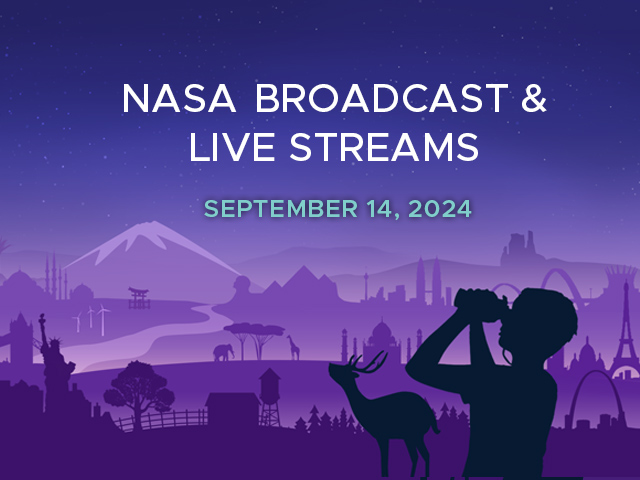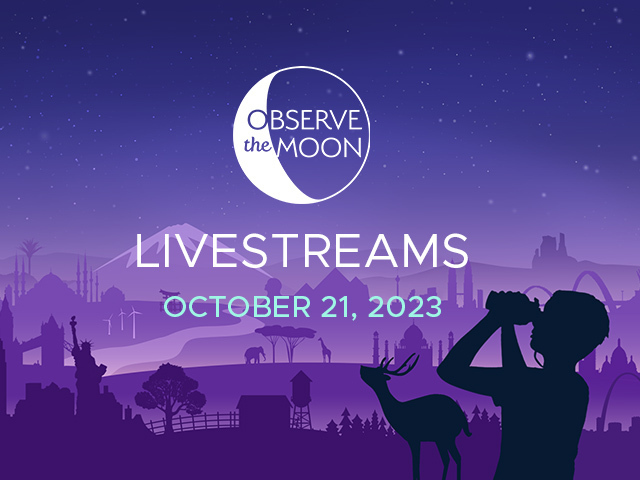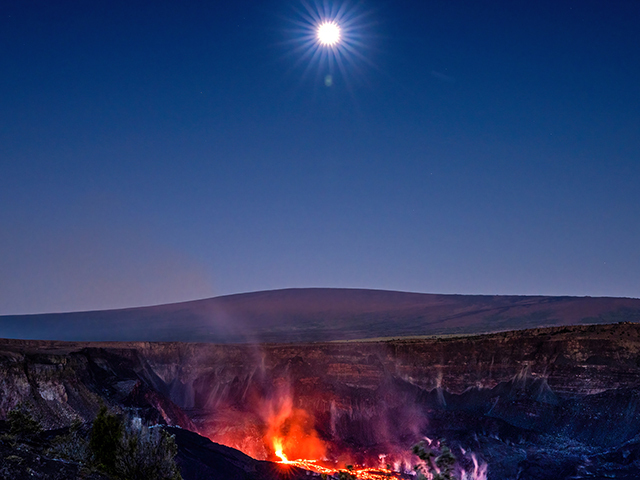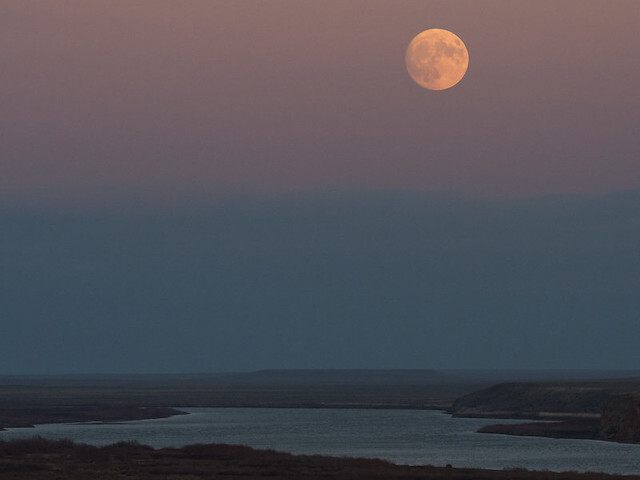News | April 23, 2018
Moon Blog: The Next Full Moon is the Flower Moon
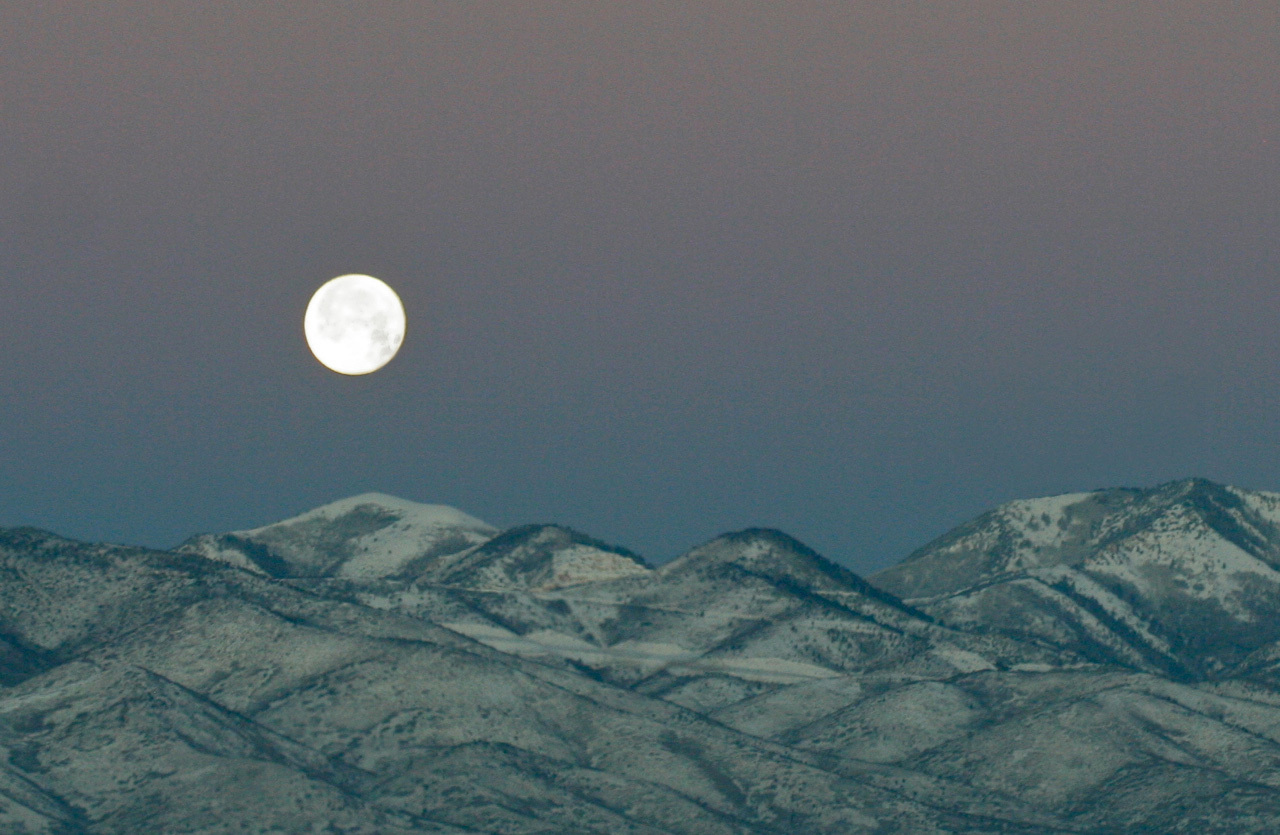
A full Moon photographed setting near Salt Lake City, Utah on Jan. 19, 2011. Credit: NASA/Bill Dunford
The next full Moon will be on Sunday evening, April 29, 2018, appearing "opposite" the Sun (in Earth-based longitude) at 8:58 PM EDT. The Moon will appear full for about three days around this time, from Saturday morning through Tuesday morning.
The Maine Farmer's Almanac first published "Indian" names for the full Moons in the 1930's. According to this almanac, as the second full Moon of spring the Native American tribes of what is now the northern and eastern United States named this the Flower Moon, as flowers are abundant this time of year in most of these areas. Other names include the Corn Planting Moon or the Milk Moon.
In lunisolar calendars the months change with the new Moon and full Moons fall in the middle of the lunar months. This full Moon is the middle of the third month of the Chinese calendar and Iyar in the Hebrew calendar. In the Islamic calendar the months start with the first sighting of the waxing crescent Moon a few days after the New Moon. This full Moon is near the middle of Sha'ban, the eighth month of the calendar, and some Moslems celebrate it as Mid-Sha'ban or Bara'at Night (Laylat al-Bara’at).
This full Moon corresponds to Vesak, also known as Buddha Purnima, a holiday (according to Wikipedia) "observed traditionally by Buddhists in Nepal, Sri Lanka, Tibet, Bangladesh, Bhutan, India and the South East Asian countries of Singapore, Vietnam, Thailand, Cambodia, Laos, Malaysia, Myanmar, the Philippines, and Indonesia. Sometimes informally called "Buddha's Birthday", it actually commemorates the birth, enlightenment (nirvāna), and death (Parinirvāna) of Gautama Buddha." The actual date of Vesak varies depending upon the lunar calendar in use in the particular country or region, but this year for most areas it falls on or near the day of this full Moon.
As usual, the wearing of suitably celebratory celestial attire is encouraged in honor of the full Moon.
As for other celestial events between now and the full Moon after next:
As spring continues, the daily periods of sunlight continue to lengthen. On the day of the next full Moon, Friday, April 29, 2018, morning twilight will begin at 5:10 AM, sunrise will be at 6:13 AM, the Sun will reach a maximum altitude of 65.7 degrees at 1:06 PM, sunset will be at 7:59 PM, and evening twilight will end at 9:02 PM EDT. By the day of the full Moon after next, Tuesday, May 29, 2018, morning twilight will begin at 4:36 AM, sunrise will be at 5:46 AM, the Sun will reach a maximum altitude of 72.8 degrees at 1:06 PM, sunset will be at 8:25 PM, and evening twilight will end at 9:36 PM EDT.
Around the time of the full Moon at the end of April, as evening twilight ends, the bright stars of the local arm of our galaxy appear low in the southwest, and as the month progresses they will shift west until they are lost in the glow of dusk. Moving or "wandering" through the sky are the planets. The word "planet" comes from the Greek word for "wanderer," as the stars are fixed in their constellations while the planets move. For the Washington, DC area, as evening twilight ends on the night of the April full Moon, the bright planet Venus as the Evening Star will appear in the west-northwest about 12 degrees above the horizon, and will appear slightly higher in the sky each evening. The bright star Aldebaran will appear near Venus in early May. The bright planet Jupiter will just be rising in the east-southeast (about 4 degrees above the horizon) but will appear higher each evening as it moves through opposition on May 8, 2018. On the night of the April full Moon, the planet Saturn will rise about a half-hour after midnight and the planet Mars will rise about an hour after Saturn. As morning twilight begins, Jupiter will appear about 17 degrees above the horizon in the southwest, Saturn will be about 29 degrees above the horizon in the south, and Mars will appear about 26 degrees above the horizon to the left of Saturn in the south-southeast. These planets will appear to shift towards the west each morning. The planet Mercury will rise in the east about 8 minutes after morning twilight begins and will appear about 5 degrees above the horizon about 30 minutes before sunrise. Mercury will appear to gradually shift towards the left (to the east-northeast) and gradually nearer the horizon each morning.
This spring should be a great time for Jupiter watching, especially with a backyard telescope (or really good binoculars). Jupiter will be at its closest and brightest for the year in the evening of May 8, 2018, (called "opposition" because it is opposite the Earth from the Sun, rising around sunset, effectively a "full Jupiter"). After May 8, Jupiter will appear to shift more towards the west, appearing higher in the evening sky (and easier to view without staying up late). Even after Jupiter passes its closest for the year, it will still be close enough to get spectacular views, only 3% further away a month after opposition. With a small telescope you will be able to see Jupiter's four bright moons, Ganymede, Callisto, Europa, and Io, shifting positions noticeably in the course of an evening. Galileo was the first person known to point the newly developed telescope at Jupiter, and he immediately noticed these moons that we now call the Galilean moons.
For navigation, especially at sea (where there are no reference points), accurate determination of longitude depends upon an accurate measurement of time. Before the development of accurate clocks in the late 1700’s, navigators considered using the moons of Jupiter as a natural clock. It was Galileo who first proposed this.
At first the predictions of where the moons of Jupiter should be were off slightly, until people realized that it took time for light to get from Jupiter to Earth and that this varied as the distance from Jupiter to Earth varied. This led to one of the earliest, relatively accurate estimates of the speed of light.
This estimate of the speed of light got better after world-wide observations of the transits of Venus in 1761 and 1769 allowed astronomers to make the first accurate measurement of the distance from the Earth to the Sun, and from this, improve our knowledge of the size of the Solar System and how the distance from Jupiter to the Earth changes over time. One of the reasons Captain Cook sailed to Tahiti was to observe the 1769 transit, and the place on the north end of the island where he and Charles Green observed the Transit of Venus is called Pointe Venus. Observing the moons of Jupiter from the rocking deck of a moving ship was difficult, so this approach never really worked well for navigation at sea, although Captain Cook, during one of his around-the-world voyages, observed Jupiter when on land to update his clocks and accurately locate the places he visited.
The Annual Lyrid meteor shower, having peaked early on Sunday morning, April 22, 2018, should remain active until Monday morning, April 30. If the sky is clear and you are away from city lights, you may be able to see some of these meteors in the early mornings, after moonset but before the sky shows any signs of dawn. On Monday morning, April 23, 2018, for the countryside near the Washington, DC area, between 3 and 5 AM EDT, the visible rate for this meteor shower should be about 9 to 10 meteors per hour. By the next night this is predicted to reduce to about 6 visible meteors per hour. The lights of the suburbs typically cuts this visibility rate in half, with the downtown city lights bringing this down by a factor of 10. This meteor shower is caused by dust from Comet C/1861 G1 Thatcher entering the Earth's atmosphere at about 48 kilometers per second (107,000 miles per hour), so fast that the air cannot get out of the way fast enough and gets compressed until it glows white-hot.
The annual Eta-Aquariid meteor shower will active from about April 21 to about May 20, and visibility is expected to peak just before the sky begins to show signs of dawn the mornings of May 8 and May 9, 2018, due to interference from the light of the waning Moon. Under ideal conditions far away from city lights, the peak rate should be about 10 meteors per hour. Due to interference from city lights, just before about 5 AM EDT for the countryside near Washington, DC, the rate should be about 7 per hour, in the suburbs about half this rate, and within the city less than 1 per hour. This meteor shower is caused by dust from Halley's comet entering the Earth's atmosphere at about 66 kilometers per second (148,000 miles per hour), so fast that the air cannot get out of the way fast enough and gets compressed until it glows white-hot. A tool for estimating the visibility of meteor showers for your location is at https://leonid.arc.nasa.gov/estimator.html
Even though they are not visible usually, I include in these Moon missives information about Near Earth Objects (mostly asteroids) that pass the Earth within about 10 lunar distances (along with a few larger ones that pass close to the Earth, because these sometimes show up in the news). I find it interesting that we have discovered so many. On Monday, April 23, 2018 at 12:28 PM EDT (2018-Apr-23 16:28 UTC), Near Earth Object (2018 GG4), between 15 and 34 meters (50 to 112 feet) in diameter, will pass the Earth at between 9.7 and 9.8 lunar distances (nominally 9.7), traveling at 14.95 kilometers per second (33,437 miles per hour).
Sometime on Monday, April 23, 2018 (2018-Apr-23 18:38 UTC with 3 hours 26 minutes uncertainty), Near Earth Object (2012 XL16), between 21 and 47 meters (69 to 155 feet) in diameter, will pass the Earth at between 15.6 and 16.8 lunar distances (nominally 15.8), traveling at 6.06 kilometers per second (13,551 miles per hour).
On Wednesday morning, April 25, 2018 at 5:00 AM EDT (2018-Apr-25 09:00 UTC), Near Earth Object (2018 GH), between 67 and 149 meters (219 to 490 feet) in diameter, will pass the Earth at between 14.5 and 14.6 lunar distances (nominally 14.5), traveling at 10.69 kilometers per second (23,922 miles per hour).
On Wednesday evening, April 25, 2018, the Pleiades Star cluster will appear low in the west-northwest about 4 degrees to the right of the bright planet Venus. For the Washington, DC area, they will be about 12 degrees above the horizon as evening twilight ends at 8:57 PM and Venus will set at 10:06 PM EDT.
Tuesday night, April 24, into Wednesday morning, April 25, 2018, the bright star Regulus will appear to the right of the waxing gibbous Moon. For the Washington, DC area, evening twilight will end at 8:56 PM, Regulus will set in the west-northwest Wednesday morning at 3:46 AM EDT, and the Moon will set 21 minutes later.
On Thursday afternoon, April 26, 2018 at 4:58 PM EDT (2018-Apr-26 20:58 UTC), Near Earth Object (2018 HP), between 15 and 33 meters (48 to 107 feet) in diameter, will pass the Earth at between 11.4 and 11.7 lunar distances (nominally 11.6), traveling at 10.31 kilometers per second (23,058 miles per hour).
Early Friday morning, April 27, 2018 at 1:09 AM EDT (2018-Apr-27 05:09 UTC), Near Earth Object (2018 GH5), between 24 and 54 meters (80 to 178 feet) in diameter, will pass the Earth at between 12.0 and 12.2 lunar distances (nominally 12.1), traveling at 12.69 kilometers per second (28,383 miles per hour).
On Friday afternoon, April 27, 2018 at 1:15 PM EDT (2018-Apr-27 17:15 UTC), Near Earth Object (2018 GB2), between 70 and 156 meters (229 to 513 feet) in diameter, will pass the Earth at between 17.0 and 17.1 lunar distances (nominally 17.0), traveling at 14.56 kilometers per second (32,559 miles per hour).
Saturday evening, April 28, 2018, as evening twilight ends, the bright star Spica will appear about 7 degrees to the right of the full Moon. As Saturday evening moves into Sunday morning, Spica will appear to shift to below the Moon as they gradually drift apart.
On Sunday morning, April 29, 2018 at 6:29 AM EDT (2018-Apr-29 10:29 UTC), Near Earth Object (2013 US3), between 160 and 358 meters (525 to 1,175 feet) in diameter, will pass the Earth at 10.1 lunar distances, traveling at 7.69 kilometers per second (17,203 miles per hour).
On Sunday morning, April 29, 2018 at 8:34 AM EDT (2018-Apr-29 12:34 UTC), Near Earth Object (2018 GO4), between 35 and 78 meters (115 to 257 feet) in diameter, will pass the Earth at between 11.7 and 11.9 lunar distances (nominally 11.8), traveling at 8.57 kilometers per second (19,177 miles per hour).
On Sunday afternoon, April 29, 2018, the planet Mercury will be at its greatest angular separation from the Sun as seen from the Earth in the morning sky, called greatest western elongation. For this apparition, even at Mercury's greatest separate from the Sun, Mercury will still be rising after morning twilight begins.
On Sunday afternoon, April 29, 2018 at 2:20 PM EDT (2018-Apr-29 18:20 UTC), Near Earth Object (2018 GY1), between 106 and 237 meters (347 to 776 feet) in diameter, will pass the Earth at between 13.1 and 13.2 lunar distances (nominally 13.1), traveling at 16.68 kilometers per second (37,322 miles per hour).
On Sunday afternoon, April 29, 2018 at 3:13 PM EDT (2018-Apr-29 19:13 UTC), Near Earth Object (2018 FV4), between 44 and 99 meters (145 to 324 feet) in diameter, will pass the Earth at 17.6 lunar distances, traveling at 6.52 kilometers per second (14,575 miles per hour).
On Sunday afternoon, April 29, 2018 at 5:15 PM EDT (2018-Apr-29 21:15 UTC with 1 minute uncertainty), Near Earth Object (2002 JR100), between 37 and 82 meters (120 to 269 feet) in diameter, will pass the Earth at between 10.7 and 10.8 lunar distances (nominally 10.8), traveling at 7.68 kilometers per second (17,188 miles per hour).
As mentioned above, the next full Moon will be on Sunday evening, April 29, 2018, at 8:59 PM EDT.
On Monday, April 30, 2018, the bright planet Jupiter will appear near the full Moon. Early Monday morning, Jupiter will appear to the lower left of the Moon, moving gradually closer together as dawn approaches. By Monday evening, the Moon will appear to have shifted so that Jupiter is to the right of the Moon, and they will appear to drift apart through Monday night into Tuesday morning.
On Wednesday afternoon, May 2, 2018 at about 2:30 PM EDT (2018-May-02 18:30 UTC with 17 minutes uncertainty), Near Earth Object (2018 HB1), between 29 and 65 meters (96 to 214 feet) in diameter, will pass the Earth at between 10.0 and 10.3 lunar distances (nominally 10.1), traveling at 9.17 kilometers per second (20,523 miles per hour).
Friday morning, May 4, 2018, the planet Saturn will appear near the waning gibbous Moon. For the Washington, DC area, the Moon will rise in the east-southeast on Thursday night at 11:33 PM and Saturn will rise to the lower left of the Moon Friday morning at 12:12 AM. They will appear to move closer together until Saturn is lost in the glow of dawn, with morning twilight beginning at about 5:02 AM EDT.
Saturday morning, May 5, 2018, the Moon will have appeared to have shifted to the other side of the planet Saturn, and Saturn will appear to the upper right of the waning gibbous Moon. For the Washington, DC area, Saturn will rise in the east-southeast at 12:08 AM, the Moon will rise at 12:23 AM, and they will appear to move apart until Saturn is lost in the glow of dawn, with morning twilight beginning at about 5:01 AM EDT.
Saturday evening, May 5, 2018, at 8:35 PM EDT, the Moon will be at apogee, at 404,457 km (251,318 miles) its farthest from the Earth for this orbit.
On Sunday morning, May 6, 2018, the planet Mars will appear to the lower right of the waning gibbous Moon. For the Washington, DC area, the Moon will rise in the east-southeast at 1:08 AM and Mars will rise at 1:19 AM. They will be about 28 degrees above the horizon in the south-southeast when morning twilight starts at 5 AM EDT.
Early on the morning of Monday, May 7, 2018, in the dark countryside near the Washington, DC area, the visibility of the Eta-Aquariid meteor shower is expected to peak at a little before 5 AM EDT, with a visible rate of about 7 meteors per hour (due to interference from moonlight). The rate over the next few mornings will be about the same as the rate of meteors and the interference of moonlight decrease together. The lights of the suburbs typically cuts this visibility rate in half, with the urban lights bringing this down by a factor of 10 or more. This meteor shower is caused by dust from Halley's comet entering the Earth's atmosphere at about 66 kilometers per second (148,000 miles per hour), so fast that the air cannot get out of the way fast enough and gets compressed until it glows white-hot.
On Monday morning, May 7, 2018 at 9:57 AM EDT (2018-May-07 13:57 UTC), Near Earth Object (1999 FN19), between 88 and 197 meters (289 to 646 feet) in diameter, will pass the Earth at 9.7 lunar distances, traveling at 5.70 kilometers per second (12,753 miles per hour).
Monday night, May 7, 2018, the waning Moon will appear half-full as it reaches its last quarter at 10:09 PM EDT.
Sometime on Monday or Tuesday, May 7 or 8, 2018 (2018-May-08 04:16 UTC with 14 hours uncertainty), Near Earth Object (2016 JQ5), between 6 and 14 meters (21 to 47 feet) in diameter, will pass the Earth at between 1.2 and 11.9 lunar distances (nominally 6.2), traveling at 10.43 kilometers per second (23,321 miles per hour).
Tuesday evening, May 8, 2018, will be when Jupiter is at Opposition, or opposite from the Sun as seen from the Earth, effectively a "Full Jupiter." This will be when Jupiter will be at its closest and brightest for this apparition, rising around sunset and setting around sunrise, making this a great time to get out a backyard telescope (or a really good pair of binoculars) and observe Jupiter's four bright moons.
On Wednesday, May 9, 2018 at 6:06 AM EDT (2018-May-09 10:06 UTC), Near Earth Object 388945 (2008 TZ3), between 221 and 494 meters (725 to 1,622 feet) in diameter, will pass the Earth at 6.5 lunar distances, traveling at 9.02 kilometers per second (20,186 miles per hour).
Early Friday morning, May 11, 2018 at 1:05 AM EDT (2018-May-11 05:05 UTC with 5 minutes uncertainty), Near Earth Object (2018 GR2), between 80 and 179 meters (263 to 589 feet) in diameter, will pass the Earth at between 13.2 and 13.4 lunar distances (nominally 13.3), traveling at 9.82 kilometers per second (21,956 miles per hour).
Sunday morning, May 13, 2018, if you have a very clear view of the eastern horizon, just before the sunrise, you might be able to see the planet Mercury appear about 5 degrees to the left of the thin crescent Moon. The pair will rise at 5:07 AM EDT and will only be 3 degrees above the horizon about 30 minutes before sunrise (which is a pretty good estimate of when the sky will become too bright to see them).
On Monday night, May 14, 2018 at 10:38 PM EDT (2018-May-15 02:38 UTC), Near Earth Object (1999 LK1), between 106 and 237 meters (347 to 776 feet) in diameter, will pass the Earth at 13.2 lunar distances, traveling at 10.03 kilometers per second (22,431 miles per hour).
Tuesday morning, May 15, 2018, at 7:48 AM EDT, will be the new Moon, when the Moon passes between the Earth and the Sun and will not be visible from the Earth. The day after the New Moon marks the start of the new month for most lunisolar calendars, and this new Moon marks the start of the fourth month of the Chinese calendar and Sivan in the Hebrew calendar.
Tuesday evening, May 15, 2018, the planet Venus will be a perihelion, its closest to the Sun in its orbit. Venus will be about 30% closer to the Sun than the Earth will be at that time, and the sunlight reaching Venus will be about twice as intense as the sunlight reaching us.
In the Islamic calendar the months start with the first sighting of the waxing crescent Moon after the New Moon. Since the new Moon is in the morning, most calendars estimate that the holy month of Ramadan, the month in which the Quran was revealed, will start the evening of Tuesday, May 15, 2018. Observing this annual month of charitable acts, prayer, and fasting from dawn to sunset is one of the Five Pillars of Islam.
Monday afternoon, May 17, 2018, at 5:06 PM EDT, the Moon will be at perigee, its closest to the Earth for this orbit. At 363,776 km (226,040 miles), the Moon will appear 11% larger in diameter than it will appear at apogee earlier in May or later in June.
On Thursday evening, May 17, 2018, the bright planet Venus as the evening star will appear about 6 degrees to the right of the thin, waxing, crescent Moon. For the Washington, DC area, they will appear about 14 degrees above the horizon in the west-northwest as evening twilight ends at 9:23 PM, the Moon will set at 10:47 PM, and Venus will set about 2 minutes later.
On Friday night, May 18, 2018 at around 10:25 PM EDT (2018-May-18 02:25 UTC with 8 minutes uncertainty), Near Earth Object (2018 GL1), between 51 and 113 meters (166 to 372 feet) in diameter, will pass the Earth at between 14.2 and 14.3 lunar distances (nominally 14.3), traveling at 5.24 kilometers per second (11,719 miles per hour).
On Monday night, May 21, 2018, the Moon will appear half-full as it reaches its first quarter at at 11:49 PM EDT. The bright star Regulus will appear about a degree to the lower left of the half-moon. For the Washington, DC area, evening twilight will end at 9:28 PM and they will appear at their closest around 11 PM, after which they will appear to move apart until Regulus sets at 2 AM EDT Tuesday morning.
On Friday night, May 25, 2018, the bright star Spica will appear about 6 degrees to the lower right of the waxing gibbous Moon. For the Washington, DC area, evening twilight will end at 9:32 PM, the Moon will reach its highest in the sky for the night at 10:30 PM, and Spica will set Saturday morning at around 3:45 AM EDT.
On Sunday night into Monday morning, May 27 to 28, 2018, the bright planet Jupiter will appear to the left of the nearly full Moon. For the Washington, DC area, evening twilight will end at 9:34 PM, the Moon will reach its highest in the sky for the evening just after midnight on Monday morning, 12:03 AM, and morning twilight will begin at 4:37 AM EDT.
On Monday night, May 28, 2018 at 10:46 PM EDT (2018-May-29 02:46 UTC), Near Earth Object 68347 (2001 KB67), between 291 and 652 meters (956 to 2,138 feet) in diameter, will pass the Earth at 9.5 lunar distances, traveling at 13.34 kilometers per second (29,838 miles per hour).
The full Moon after next will be on Tuesday morning, May 29, 2018, at 10:20 AM EDT.


